Sourdough Sandwich Bread with a Soft Crust
Sourdough Sandwich Bread is made with milk, butter & active sourdough starter. This soft crust sourdough bread has a tender crumb and awesome flavor. It makes a perfect sandwich.
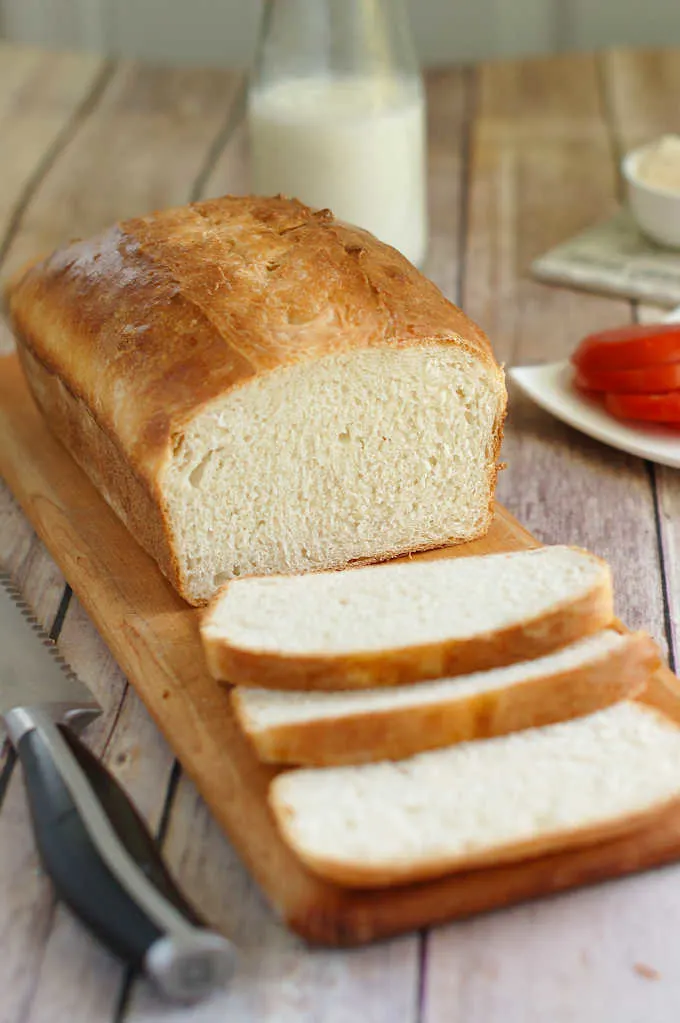
Table of contents
Why this is the best Sourdough Sandwich Bread
White Sandwich Bread doesn’t have to have the lackluster taste and squishy texture of a certain “wonderous” bread that many of us ate growing up. This sourdough sandwich bread has deep flavor, a beautiful texture and a soft crust.
Milk, butter and a whisper of sugar create a perfectly soft white bread that is ideal for making a great PB&J or BLT.
Although this recipe takes a good 8-12 hours from start to finish, the vast majority of the time is hands off.
To make this recipe even more convenient, you can let the dough rise over night. A long rise in the refrigerator does only good things for the bread.
If you don’t already have one, I can show you how to make a sourdough starter and how to feed a sourdough starter.
Ingredients

Ingredient Notes
- Sourdough Starter – This recipe was developed using 100% hydration starter. You will need to adjust the liquid or flour in the recipe if you’re starter isn’t at 100% hydration.
- All Purpose Flour – Medium protein AP flour makes a bread with a soft crumb yet develops enough gluten so the bread rises high in the oven.
- Milk – Scalding denatures (breaks down) proteins in the milk which can interfere with gluten development.
- Butter – A little fat softens the crumb of the bread.
- Salt – For flavor.
- Sugar – Enhances browning and make the crumb soft and slightly sweet.
How to make Sourdough Sandwich Bread with a soft crust
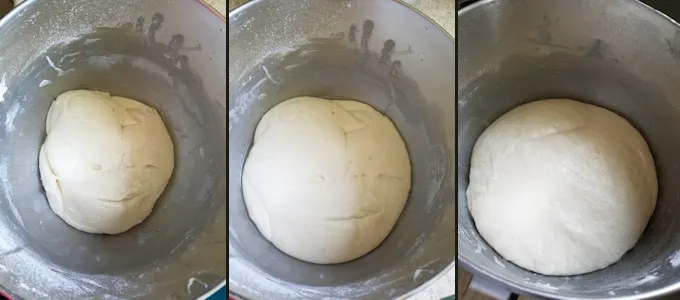
- Mix the dough and set it aside for the initial fermentation.
- With each hour of fermentation the dough will rise higher, become more active and more elastic.
- After the initial fermentation you can continue on to shape and bake the loaf, or you can refrigerate the dough overnight and continue the next day. A long, cool rest in the refrigerator enhances the flavor and texture of the dough.
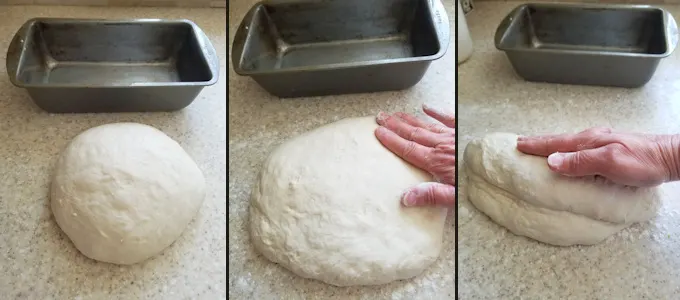
- Turn the dough out onto a lightly floured surface.
- Without kneading out the air, gently form the dough into a rectangle.
- Roll the rectangle into a log and set into a lightly greased loaf pan.
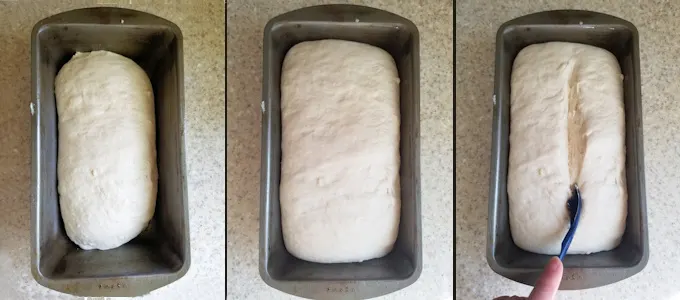
- Cover the pan and set the loaf aside to rise.
- The dough will expand to almost fill the pan.
- Slash the top of the loaf to promote even rising in the oven.
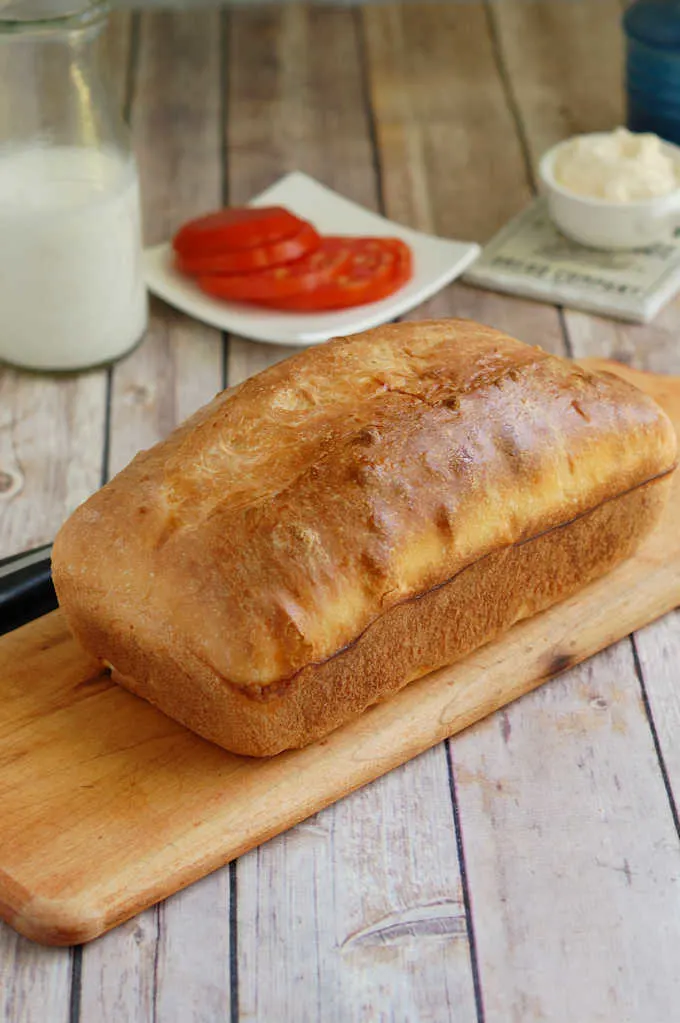
- Brush the loaf with egg wash and bake until the interior temperature is 200F.
- Cool the loaf completely before cutting.
A timeline for making Sourdough Sandwich Bread:
- If your starter needs feeding, do that the night before or early in the morning of the day you want to make the dough.
- Mix the dough in the afternoon, allow it to ferment for 3-4 hours then refrigerate the dough before going to bed.
- Take the dough out of the refrigerator first thing in the morning, shape the loaf and set it into the pan.
- To warm up the dough, turn on the oven just until it’s barely warm. Turn off the oven and set the pan with the cool dough in the oven. Remove the pan once the dough is back to room temperature. You can skip this step, but it does speed up the rising time.
- Leave the loaf to rise for 1 1/2- 2 hours, or as long as is needed to almost double in size.
- To make and bake the dough in the same day, feed your starter the evening before so it’s active by morning. Start the dough early in the morning and it should be ready to bake by late afternoon or early evening.
Storage
Sourdough Sandwich bread will keep at room temperature for 2-3 days. The bread (sliced or whole) can be frozen for up to a month.
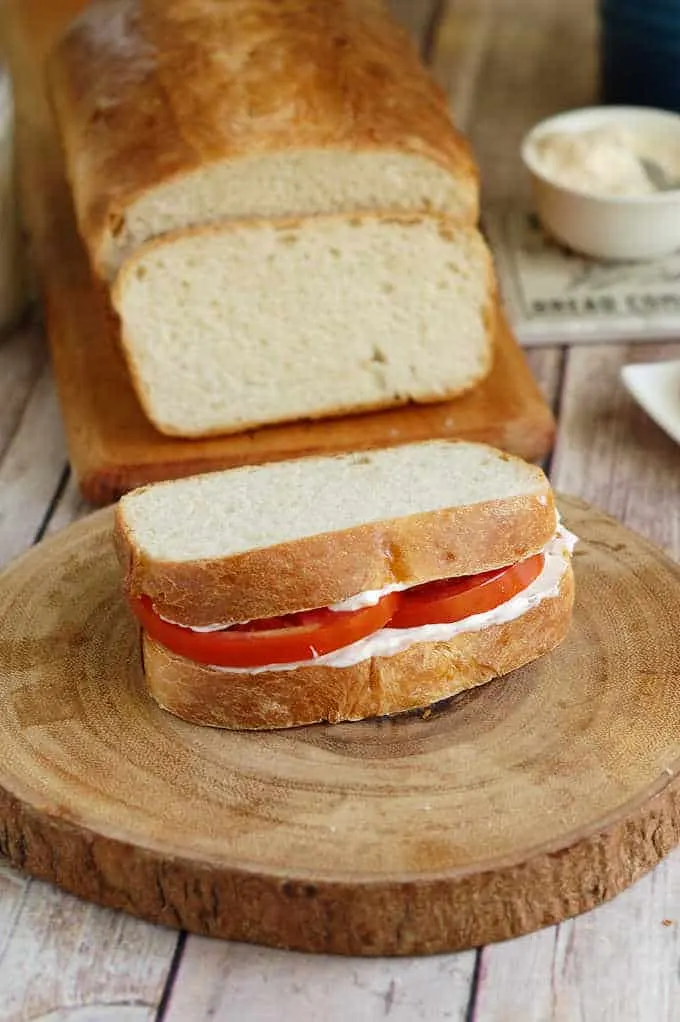
I know you hate to throw away that sourdough discard. Check out these recipes that use sourdough discard.
More great sourdough breads
- Whole Wheat Sourdough Bread
- Sourdough Hoagie Rolls
- Sourdough Multigrain Bread
- Sourdough Semolina Bread
- Sourdough Rye Bread
- Crusty Sourdough Bread
If you love this recipe as much as I do, I’d really appreciate a star rating and a quick comment. Ratings and comments help my recipes show in search results. Thanks!
Sourdough Sandwich Bread Recipe
Ingredients
- 8 oz whole milk (1 cup)
- 1 oz unsalted butter
- 8 oz active sourdough starter (1 cup, 100% hydration)
- ½ oz granulated sugar (1 tablespoon)
- 1 ½ teaspoons salt
- 12 ½ oz all purpose flour (2 ½ cups, see note)
- 1 large egg (for egg wash)
Instructions
- Warm 8 oz whole milk in the microwave to until scalding hot (just before it comes to a boil.) Stir 1 oz unsalted butter into the warm milk to melt. Set the milk aside to cool until it's slightly warmer than body temp.
- In a mixer bowl, combine the warm milk with 8 oz active sourdough starter, ½ oz granulated sugar and 1 ½ teaspoons salt and stir to combine. Add 1 ½ cups of the flour and stir until the batter looks like thick pancake batter. If using a stand mixer, change to the dough hook.
- With the mixer running, slowly add the remaining flour until the dough gathers on the hook and clears the sides of the bowl. Knead for 5 minutes. If mixing by hand, stir in as much flour as you can then turn the dough out onto a floured surface and knead in the remaining flour.
- Remove the dough from the bowl onto a lightly floured surface. The dough should be soft and slightly sticky. Knead to form a smooth ball. If the dough is very sticky sprinkle a little more flour as you knead.
- Place the dough in an oiled bowl, turning once to coat the dough. Cover the bowl and set it aside at room temperature.
- After 60 minutes uncover the bowl, lift one side of the dough and fold it into the middle of the dough. Repeat with the other three sides of the dough then flip the dough over. You're basically turning the dough inside-out to redistribute the yeast and strengthen the gluten. Cover the bowl and after 60 minutes repeat the procedure.
- Cover the bowl and after 60 minutes fold the dough one more time. By now the dough should be lively, elastic and airy. If the dough is still sluggish give it another hour or two at room temperature. If you want to finish making the bread in the morning return the dough to the bowl, cover tightly and refrigerate overnight. The next morning continue with shaping. Otherwise continue shaping the loaf on the same day.
- Grease a 9"x 5" loaf pan with a very light film of vegetable oil.
- Turn the dough out onto a floured surface and without kneading out the air, gently push the dough to a 9" rectangle. Tightly roll the dough to form a log.
- Set the dough into the pan and cover with a damp kitchen towel or oiled plastic wrap. Set in a warm place and rise until the dough is doubled in size, about 1-1½hours.
- Preheat the oven to 350 °F. Use a sharp knife or razor to cut a 1/2" deep slash down the center of the loaf. Brush the loaf with egg wash.
- Bake about 30-35 minutes until golden brown and and a toothpick inserted in the center comes out clean. The interior temp should be 200 °F.
- Cool in the pan for 5 minutes before turning out onto a cooling rack. Finish cooling to room temperature before slicing,
Would you like to save this recipe?
As an Amazon Associate and member of other affiliate programs, I earn from qualifying purchases.








Fantastic recipe! I am struggling to get the high grade and wholemeal flour I use for my usual sourdough baking and this works brilliantly with the medium protein flour I have been able to find. Thank you.
You’re welcome. It also freezes really well. I have a sliced loaf in the freezer now. Often, instead of throwing away starter, I’ll bake extra loaves and freeze.
Hi, I was just reading through comments and came upon yours. I am a sourdough newbie and like most people viewing and testing out Eileen’s recipe, I am loving it! I was buying four from the supermarket, and somedays flour is hard to come by with everyone at home becoming bread bakers…LOL!
I actually went directly to the source and purchased a variety of whole meal flour from a mill. Yes, the flour is higher in price, but also higher in quality. They actually have the date on the flour bag when the flour was milled.
The mill I went to was Sunrise Flour Mill our on MN, but they are just one of many you can purchase from directly. I actually purchased two of the blends in 10 lb bags.
I made this for the second time today and it turned out a lot better second time round (I think I missed a few steps the first time, oops!) Really enjoyed the texture of the bread and the fact that it can be sliced so thinly – a lot of homemade breads I make have to be sliced a lot thicker. Enjoying the time at home to experiment with different breads, so thanks for the recipe!
*second time in a week, not second time today, oops
Thanks for this recipe! We love it soooo much
Wondering if it would turn out if I substituted part whole wheat or if it will then lose its softness and wonderful texture? Any chance you’ve tried?
Hi Hailie, yes you could substitute some of the flour with whole wheat flour. You could probably use about 1/2 to 1 cup of whole wheat flour. I would start with 1/2 cup and if you like that you can try adding a bit more whole wheat next time.
Thank you! Excited to try this modification today
I’m unclear on step 7. I will be using the refrigerator method, but how long am I knead the dough before it goes into the fridge?
Typo… but how long am I to* knead the dough before…
Sorry, that wasn’t very clear. I’ve edited the recipe to make it clear that at that point you will repeat the “folding” procedure. I just made this bread myself today and it is a really good sandwich bread.
Ok,gotcha! Thanks for replying so quickly – appreciate it!!
I should also note that I made the dough for this bread yesterday and just let it hang out on the kitchen counter all afternoon and just put it in the refrigerator when I went to bed. The time is very, very foriving.
I made it yesterday\today and it was delicious! The whole family loved our sandwiches. Thanks for the recipe!
You are welcome!
Hi, I’ve recently been baking a lot of artisan sourdough breads. The crust is crispy, inside soft and chewy. I mean I’ve tried store bought artisan loaves and their texture is the same as mine. Mine actually taste better lol.
Every recipe I’ve used takes four ingredients- flour, water, salt and starter. I’ve cooked inside Dutch ovens for better oven spring and it works wonderful. But my wife wants a soft crust. A really good bread for sandwiches. These artisan loaves are delicious with soups and spreads, good as toast or even a slice by itself but I just don’t believe they’re meant for sandwiches unless I’m doing something wrong.
I have a cinnamon roll dough recipe that I’ve actually used for breadsticks, dinner rolls etc – it’s amazing. How can a dough meant for cinnamon rolls turn out so perfect as a dinner roll. So soft, airy, buttery and fluffy. I’m addicted to the rolls. What’s the difference? It seems only milk, eggs and sugar.
I’m new to all this so bare with me – but what makes sourdough “sourdough” – is it the fact I’m using a starter? I’m also still working on getting more tang, four loaves this week and still not as tangy as I’d like it. Retarding overnight seems to be doing something but still not where I want it to be. I’m driving my wife insane. My first loaf was sour and now 4 loaves later barely sour. I want more tang lol. Please advise. I’m sorry for all the questions. I’m just going nuts lol. Any simple tip or trick that will definitely give me a more sour loaf of bread?
Hi Chris, I don’t know if you’ve made this recipe yet, but I think it’s the soft sandwich bread your wife is looking for. I agree that the artisan sourdough breads are delicious, but maybe not the best sandwich bread. In fact, I knead my crusty sourdough briefly before shaping just to knock out some of the biggest holes.
Yes, milk, eggs and sugar will tenderize the dough and could be baked in different forms.
Sourdough is infinitely interesting and since I closed my cake business I’m just now having time to play and experiment. I consider anything that starts with a starter with natural yeast a “sourdough”. A sourdough doesn’t necessarily taste sour. I’ve read lots of theories of how to get a more sour flavor in the dough. I think it’s about the types of acid produced as the yeast eats the sugar. The more time the dough spends in the refrigerator, the more acetic acid is produced as opposed to lactic acid. You may have noticed that if you leave your starter too long in the refrigerator without feeding it smells quite sharp. In the near future I plan to do some side by side bakes to test the different techniques. In the meantime, if you click on the recipe link at the top you’ll see a drop down menu. There’s an entire category of sourdough recipes you can try, including cinnamon buns and donuts that are to die for. Thanks for reading!
Mine gets less sour if I make bread more often which means I’m feeding it more often. It goes sour again when I feed it less.
Yes! I’ve found my dough has a nice sour flavor if I feed my starter every other day instead of every day.
I actually have 2 starters going. One that I feed every day, that makes lovely mild bread and cinnamon rolls as wells as the one I feed every other day-ish (only when it starts smelling sharp), that gives me much more typical “sour flavor”. Also I’ve found my starter is more sour if it is kept just a bit drier than most instructions recommend…I remember reading somewhere that the yeast that produces acetic acid prefer a slightly drier environment vs the ones that prefer a slightly wetter environment.